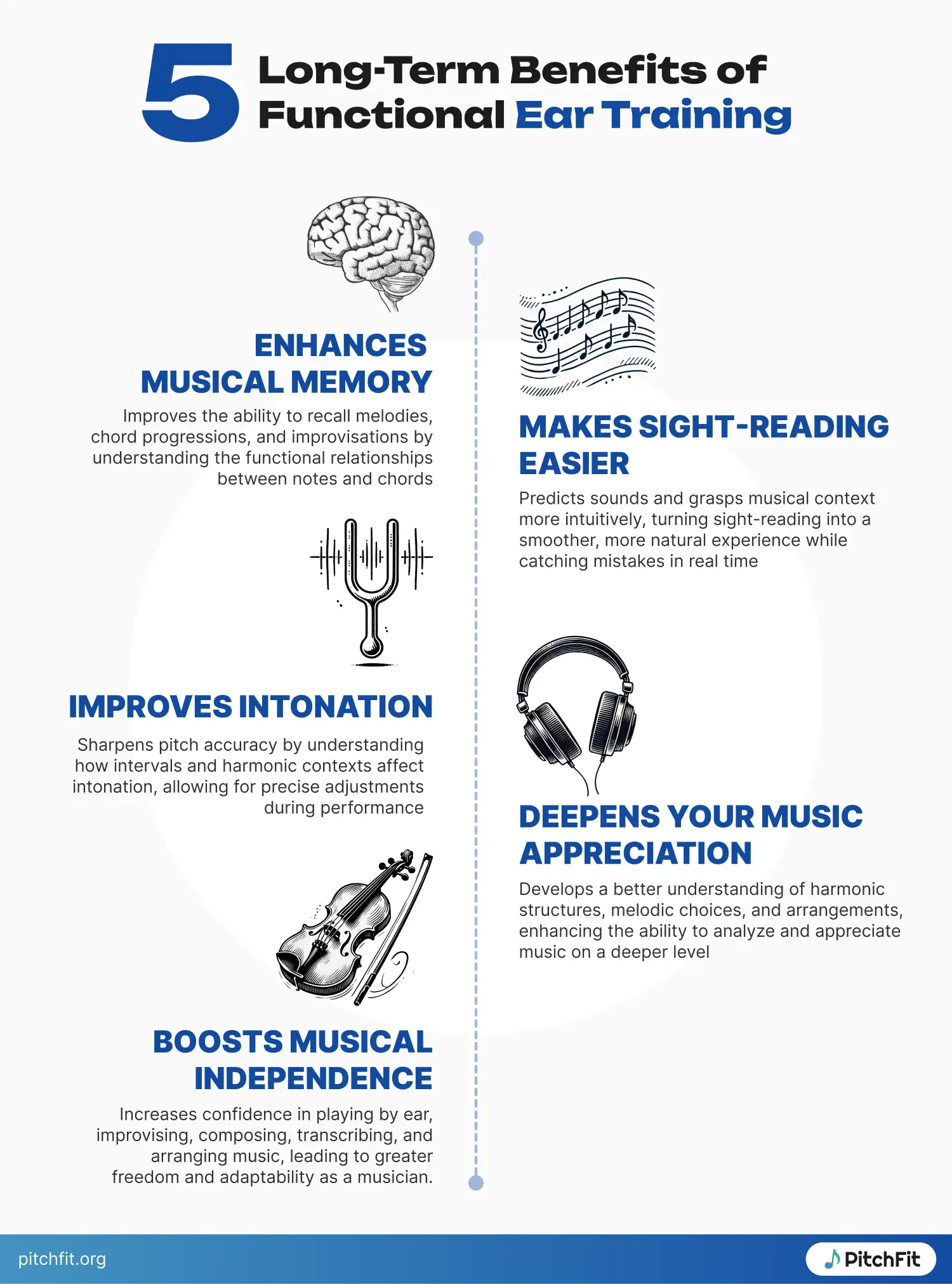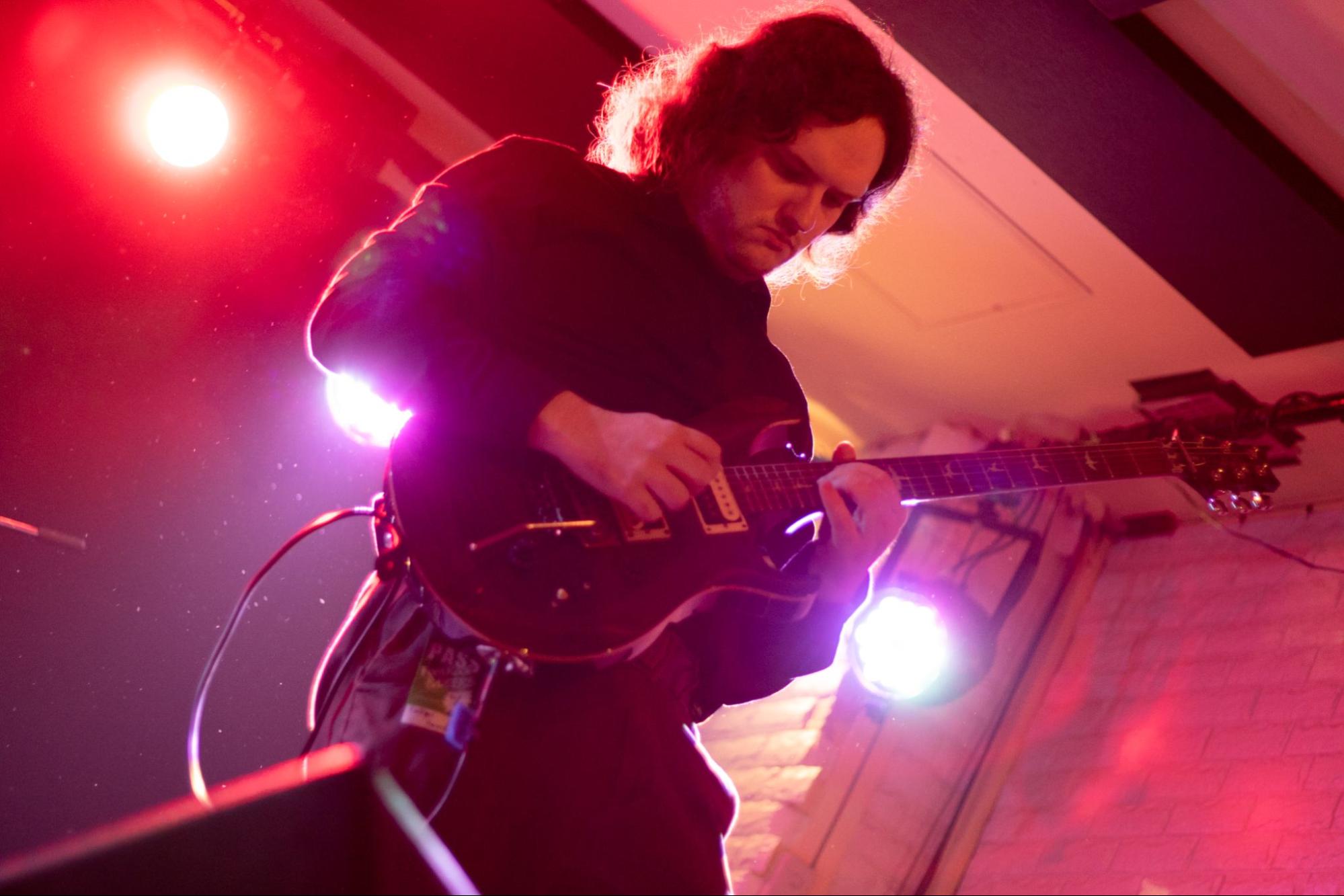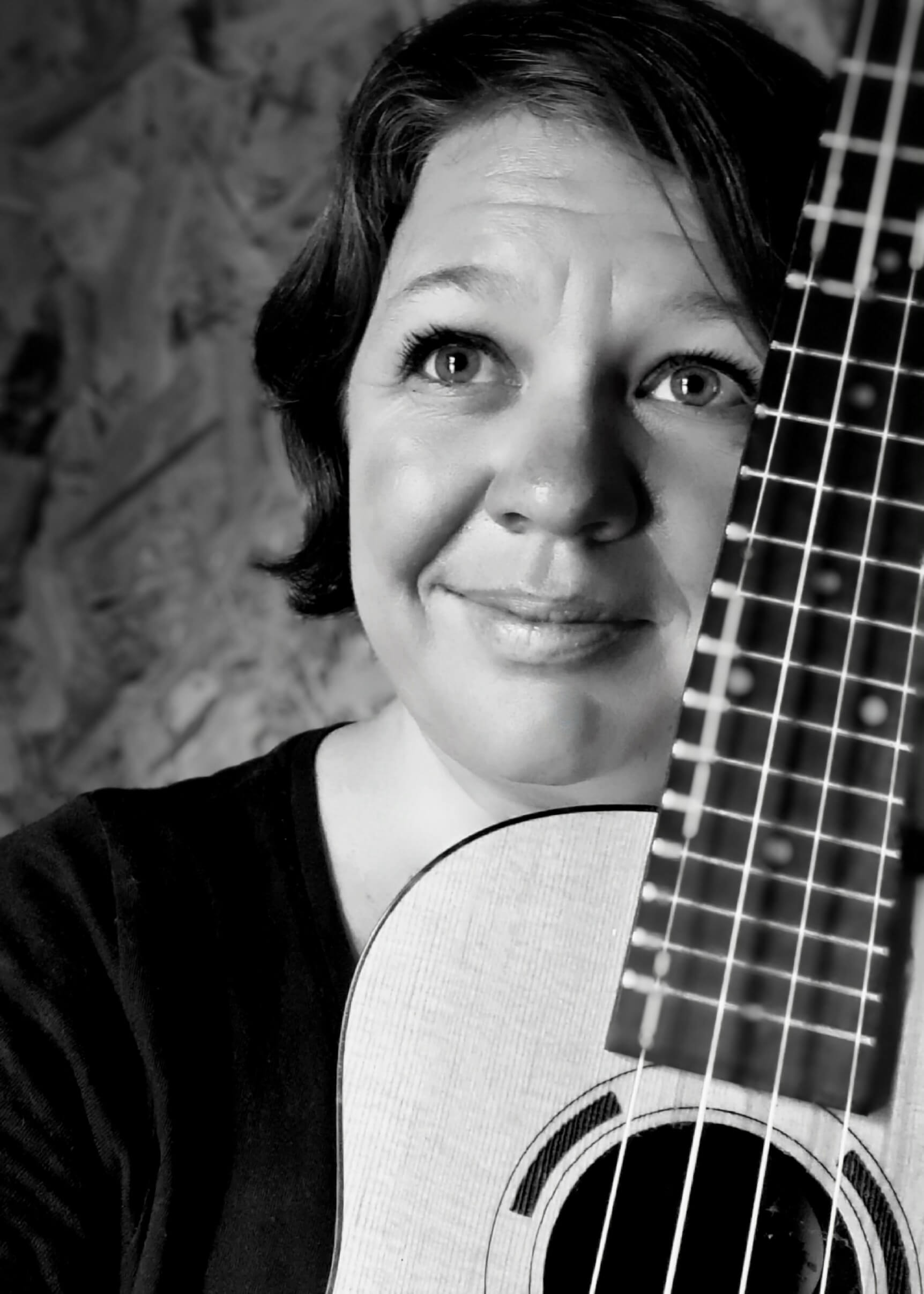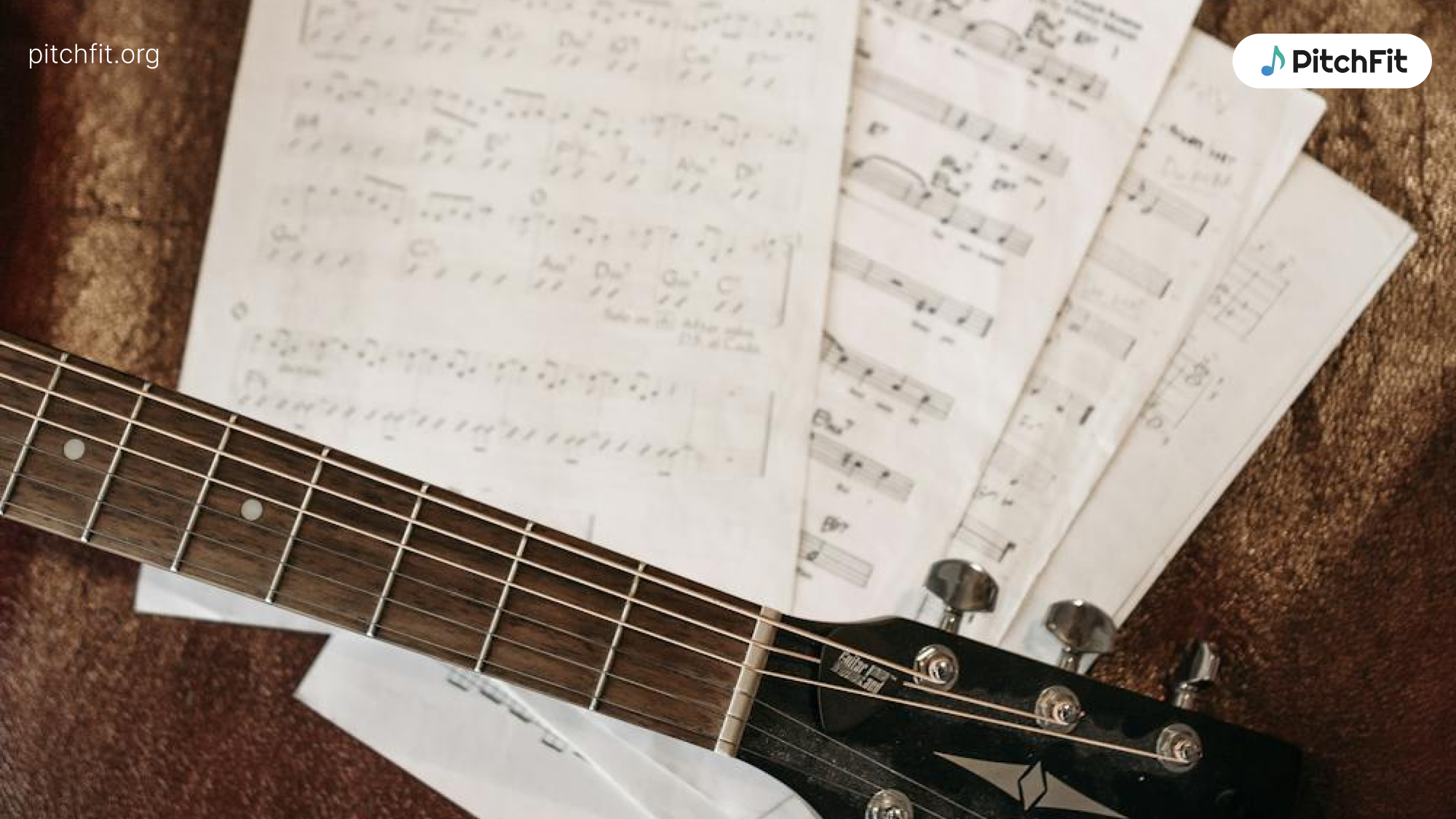Functional ear training is the practice of training your ear to recognize how notes, intervals, and chords function within a tonal context, rather than just hearing them as isolated sounds.
In other words, it helps you understand how notes work together in a song, making it easier to identify chord progressions and melodies, or even predict where a piece of music is headed.
Functional ear training works by teaching you to hear notes in relation to a key center. For example, in the key of C major, you learn to hear C as the "home" note, G as the "leading" note, and so on. You practice identifying scale degrees and chord functions within a musical context, gradually building an intuitive understanding of tonal relationships. This approach helps you develop a more natural and musical way of hearing.
This training improves many areas of musicianship. In this article, we’ll explore how functional ear training can transform the way you hear, play, and appreciate music.

1. It Improves Your Musical Memory
Imagine having a vast library of musical ideas at your fingertips, ready to be recalled at a moment's notice. That's what functional ear training can do.
- Melody recall: As you train your ear to recognize scale degrees and intervals, melodies become sequences of functional relationships rather than just a series of notes. This makes it easier to remember and reproduce them. You might find yourself humming a song you heard just once, able to recreate it accurately because you've internalized its functional structure.
- Harmonic memory: Understanding how chords function within a key helps you remember chord progressions more easily. Instead of thinking "G, C, Am, D," you might think "I, IV, vi, V." This is both easier to recall and easier to transpose or recognise in another key.
- Improvisation memory: Functional ear training helps you remember your improvisations, turning spontaneous creativity into reproducible ideas. You'll be able to recall that killer lick you played last night because you understand how it functioned in the context of the harmony.
Jazz musicians often use their functional hearing to memorize standards. By understanding the functional relationships in the harmony, they can internalize and recall hundreds of tunes, ready to play in any key.
2. It Improves Your Sight-Reading
Sight-reading can be daunting, but functional ear training turns it from a decoding exercise into a fluid, musical experience.
- Predicting sounds: As you develop your functional hearing, you'll start to predict how written music will sound before you play it. This inner hearing (audiation) makes sight-reading feel more natural and intuitive, just like reading a book.
- Contextual understanding: Functional ear training helps you understand the context of what you're reading. You'll quickly grasp whether a note is the root, third, or seventh of a chord, informing your understanding and interpretation of the music.
- Error detection: When you can audiate the music as you read it, it becomes much easier to catch and correct mistakes in real time. You'll know something doesn't sound right because it doesn't match your functional expectations. It will sound wrong in your head.
Orchestral musicians often need to sight-read complex pieces in rehearsals. Those with strong functional hearing can quickly grasp the musical context and their part's role within it, leading to more efficient rehearsals and polished performances.
3. It Improves Your Intonation
For instruments with flexible pitch (like voice, violin, or fretless bass), functional ear training is your path to impeccable intonation. This is even the case for some fretted instruments that allow pitch bends, such as the guitar.
- Relative pitch awareness: Understanding how intervals should sound helps you intuitively adjust your pitch to a given context. You'll intuitively sense when a note is too sharp or flat relative to its context, rather than hearing it as an isolated sound. This can also allow you to more easily play in alternative tuning systems. You’ll remember the intervals, rather than the absolute pitches of notes.
- Harmonic context: Functional ear training helps you tune notes in relation to the underlying harmony, not just to a fixed reference pitch. This leads to more musical and expressive intonation. Violin players often sharpen or flatten notes to better fit the harmonic context.
- Micro-adjustments: As your ear becomes more sensitive to functional relationships, you'll make micro-adjustments to your pitch that align perfectly with the harmonic context, elevating the overall sound of any ensemble you're part of.
A cappella groups rely heavily on functional hearing for their impeccable tuning. Each singer needs to understand their note's function within a given context to maintain pristine intonation without instrumental reference.
4. It Deepens Your Appreciation of Music
Functional ear training doesn't just make you a better performer; it transforms how you listen to and appreciate music.
- Harmonic analysis: You'll start to hear the underlying harmonic structures in music, appreciating how composers use chord progressions to create emotion and drive the music forward.
- Melodic intention: Understanding scale degrees helps you appreciate the intentionality behind melodic choices. You'll hear how composers and improvisers use certain scale degrees to create tension, resolution, or surprise.
- Arrangement insights: With developed functional hearing, you'll start to pick apart arrangements, understanding how different instrumental parts interact and support each other.
- Historical context: As you listen to music from different eras and cultures, you'll gain insights into how functional relationships have evolved over time and vary across musical traditions.
Film composers use their deep understanding of functional relationships to create emotionally impactful scores. They know exactly which scale degrees and chord functions will evoke specific emotions in the audience.
5. It Gives You Musical Independence
Perhaps the most liberating benefit of functional ear training is the musical independence it fosters. These skills will allow you to boost your confidence and adaptability as a performer and grow as a musician.
- Playing by ear: As your functional hearing develops, you'll find yourself able to pick up songs by ear more quickly and accurately. You'll intuitively understand the structure of the music you're hearing, perhaps even after a single listen.
- Improvisation: Functional ear training is a gateway to more confident and creative improvisation. You'll be able to predict how notes will sound over different chords, allowing you to make bold and intentional choices in your solos.
- Composition: Understanding functional relationships opens up new avenues for composition. You'll have a deeper toolbox of harmonic and melodic ideas to draw from, and you'll be able to hear how your compositions will sound before you even play them.
- Transcription: With strong functional hearing, transcribing music becomes much easier. You'll be able to quickly identify chord progressions and melodies, turning recorded music into written notation with ease.
- Arrangement: Functional hearing allows you to reimagine existing music in new ways. You'll be able to create unique arrangements by understanding and then creatively altering the functional structure of a piece, all while maintaining the core essence of the original.
Session musicians often rely on their functional hearing to quickly learn and adapt to new material. They might be given a chord chart or even just told a key, and their functional understanding allows them to create appropriate musical parts on the spot.
The Compounding Effect of Functional Ear Training
What's truly exciting about these benefits is how they compound over time. As your functional hearing improves, you'll become a better sight-reader, which exposes you to more music, further developing your ear. Your improved intonation, improvisation, and ability to learn new music will make you a more in-demand player, giving you more opportunities to apply and refine your skills. Your deeper appreciation of music will inspire you to explore new genres and techniques, continuously expanding your musical horizons. You’ll be able to appreciate the complexities and functionality of music you may have previously ignored.
Functional ear training is not a destination but a journey – one that continues to reward you with deeper musical understanding and more profound musical experiences throughout your entire musical life. So keep at it! Every minute you spend on functional ear training is an investment in a richer, more fulfilling musical future. Your ears (not to mention fellow musicians and audiences) will thank you!
Frequently-Asked Questions
1. What’s the difference between interval ear training and functional ear training?
Interval ear training focuses on recognizing the distance between two notes, hearing them as isolated intervals like major thirds or perfect fifths. Functional ear training, on the other hand, teaches you to hear notes within the context of a key or tonal center. It’s less about identifying intervals in isolation and more about understanding how each note functions relative to the tonic or underlying harmony. This makes functional ear training a more comprehensive tool for musicians looking to understand how music fits together harmonically.
2. Does functional ear training help with improvisation?
Functional ear training allows you to anticipate how different notes and chords will sound within a given key. This is incredibly useful for improvisation because it gives you the ability to make intentional choices when playing over a chord progression. Instead of guessing, you can confidently predict which notes will create tension, resolution, or surprise, helping you improvise with more creativity and fluency.
3. Do I need to know music theory to start functional ear training?
While knowing some basic music theory can be helpful, it’s not a requirement. Functional ear training is all about listening and understanding how notes work together in context. As you practice, you’ll naturally develop a better understanding of music theory concepts, but you don’t need to be an expert to get started.




